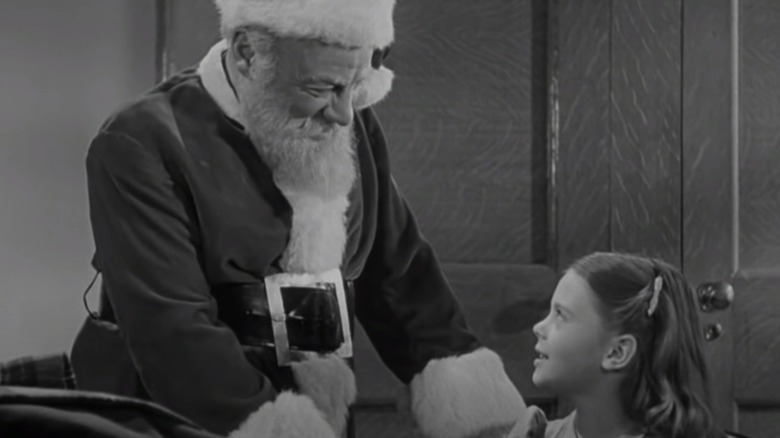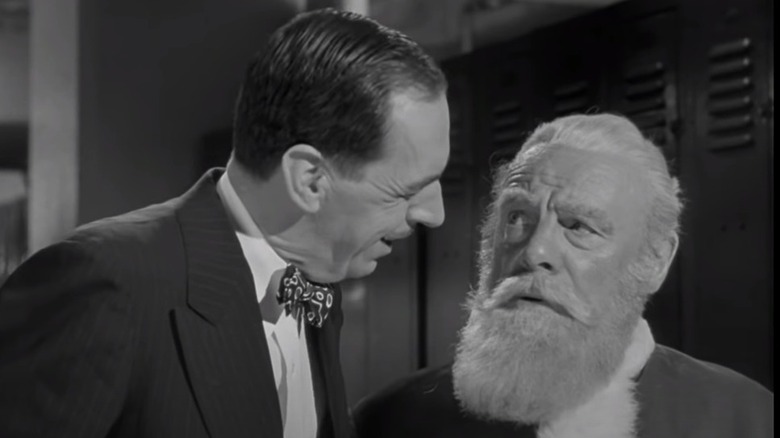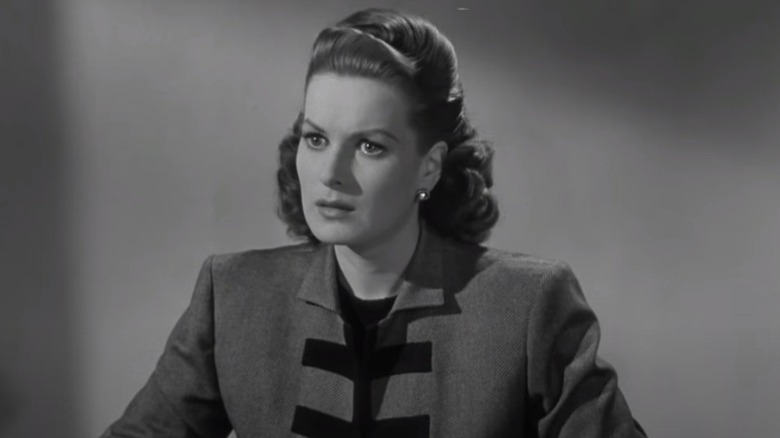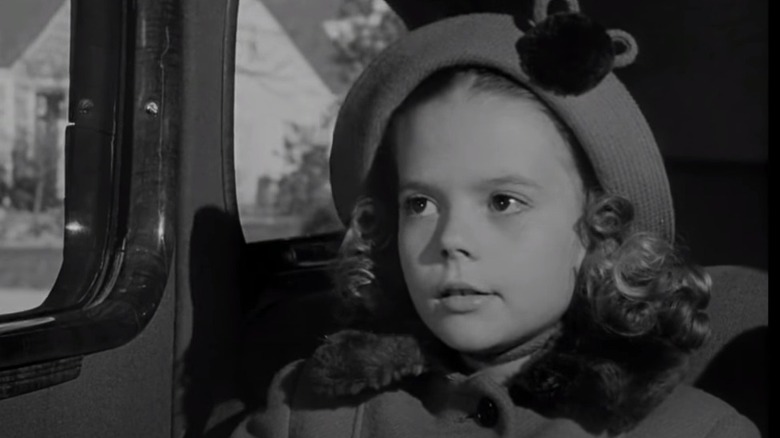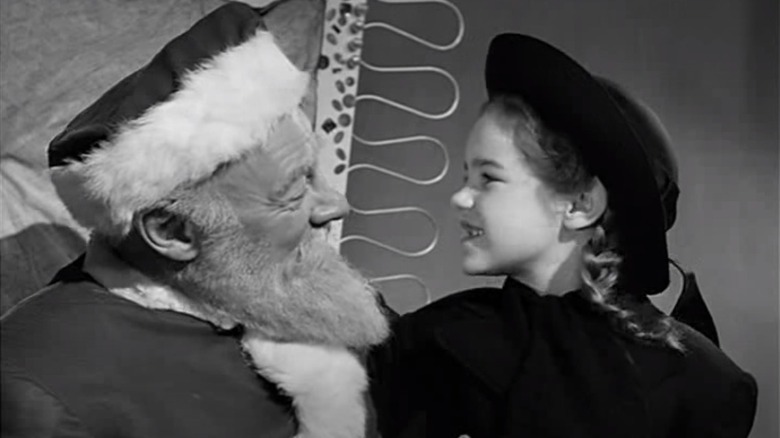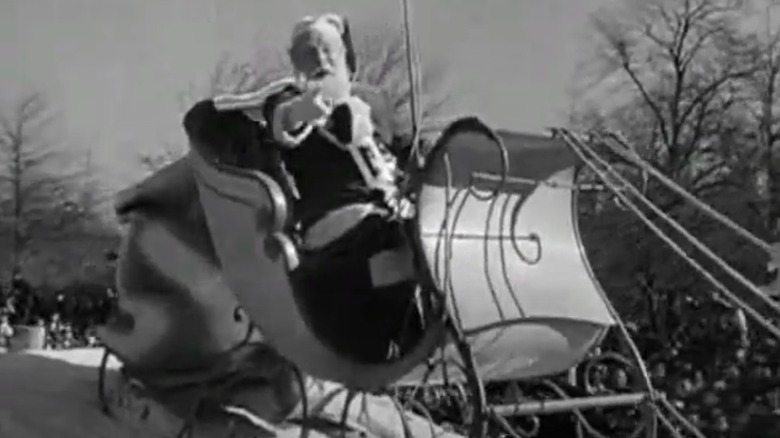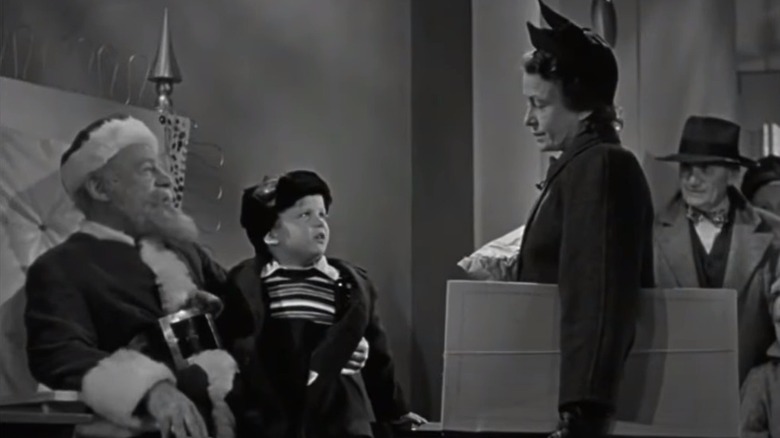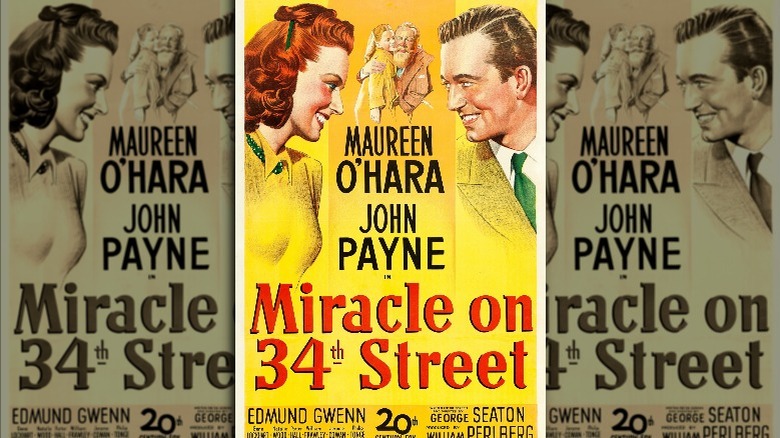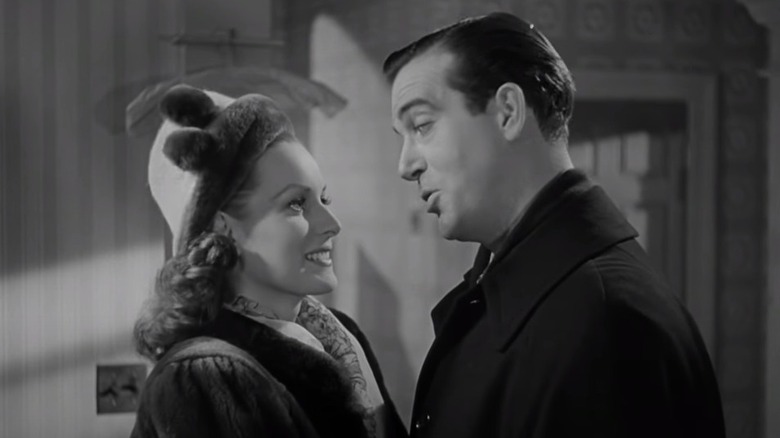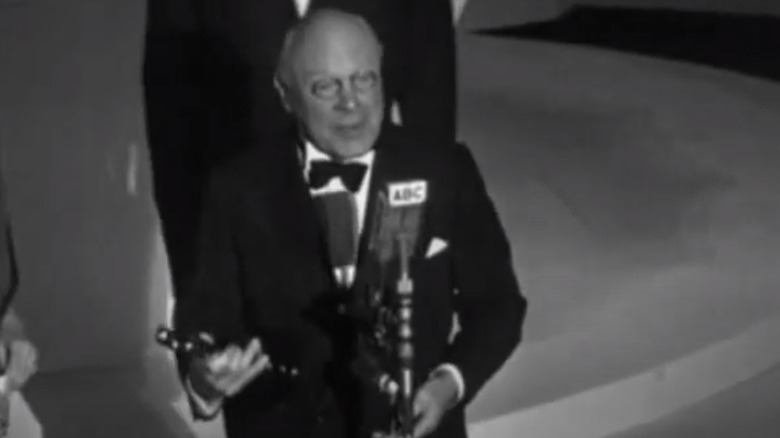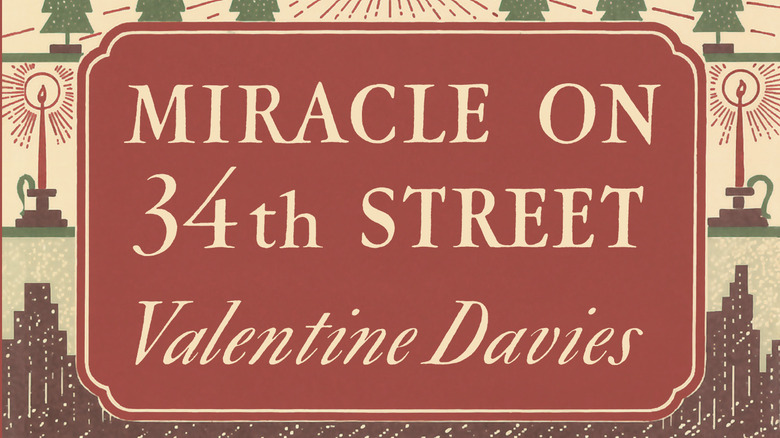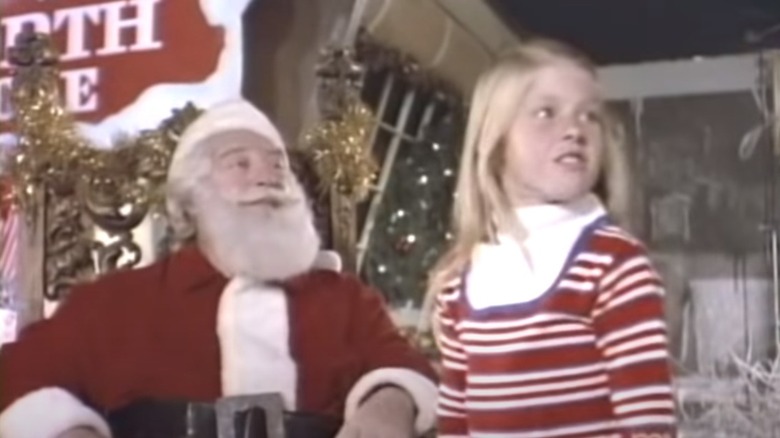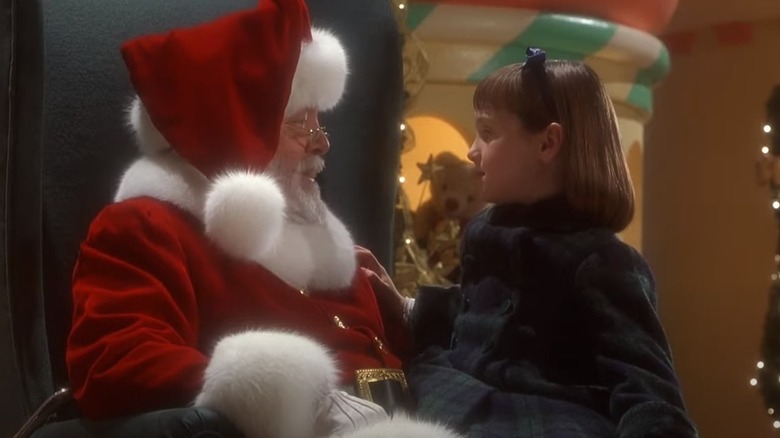The Untold Truth Of Miracle On 34th Street
The cynical daughter of a single career woman discovers the real magic of Christmas thanks to a mysterious stranger who may be the real Santa Claus in director George Seaton's "Miracle on 34th Street." Set against the backdrop of a battle between New York retail giants Macy's and Gimbels as they vie for the lion's share of the holiday shopping dollar, the film tackles Christmas commercialism head-on in a way that's never cloying or mawkish. Starring 8-year-old Natalie Wood in a career-making performance as the precocious Susie Walker, the witty and beautiful Maureen O'Hara as harried Macy's event director Doris Walker, John Payne as true-believing lawyer Fred Gailey, and veteran British actor Edmund Gwenn in an Oscar-winning turn as Kris Kringle, "Miracle on 34th Street” is perfectly cast, deftly written, and superbly directed. Appealing to both children and adults, it's the rare holiday picture that never wears out its welcome.
With the enduring message, "Christmas is a frame of mind," the film has become a staple of the holiday season with a reputation that has only grown with decades of repeated television airings, radio, TV, and stage adaptations, and a 1994 big screen remake. An instant hit, "Miracle on 34th Street" delighted critics and audiences alike upon its initial release in the spring of 1947. Yet, it began as a film in which few besides writer Valentine Davies and director George Seaton had faith. "Miracle on 34th Street's" journey to becoming a holiday classic is nothing short of miraculous.
Inspiration strikes
Appropriately enough, the story behind "Miracle on 34th Street" begins on Christmas Eve, 1944. As detailed in a 2001 episode of the AMC documentary series "Backstory," screenwriter Valentine Davies was picking up a last-minute Christmas gift for his wife when he found himself crushed in a bustling crowd of shoppers at a Los Angeles department store. Dismayed by the feeding frenzy of unbridled consumerism and the crass commercialization of the holiday, Davies began to wonder what Santa Claus would think of what had happened to Christmas.
Inspired by his holiday musings, he began working on a story that would tackle the problems of the modern American Christmas celebration. Believing that there might be cinematic potential in the concept, he took the idea to his friend, writer director George Seaton. Seaton explained the origins of their collaboration in an interview curated by the American Film Institute. "Val [Davies] and I were talking. It was near Christmas time and we were getting so teed-off at the commercialism of Christmas," Seaton explained. "And Val said, 'Geez. Imagine if Santa Claus came back. What would happen?'" The friends soon began hammering the concept into a script. However, there was one important point on which the two couldn't agree. Davies insisted the Santa of their story was the real McCoy while Seaton insisted he had to be a man who merely thought he was Santa. Ultimately, that ambiguity would become the cornerstone of the film's plot.
Maureen O'Hara's short homecoming
By 1947, Dublin-born actress Maureen O'Hara had established herself as one of Hollywood's most talented and beautiful leading ladies. A favorite actress of legendary director John Ford, she was known as the Queen of Technicolor because of her stunning natural red hair and green eyes, but by the decade's end, she was ready for a break from Hollywood. With the cessation of hostilities in Europe two years earlier, she decided the time was right to return to Ireland in 1947.
However, as detailed in O'Hara's autobiography "'Tis Herself," her long-awaited homecoming was cut short. Just days after landing in Ireland, she received an urgent phone call from 20th Century Fox ordering her to report back to the U.S. immediately. Under contract, the actress had no choice but to follow through with the studio's demands. "I was madder than a wet hen the whole flight back," O'Hara writes. "'How dare they,' I fumed. 'How dare they force me back just to make a silly little movie about Santa Claus!'"
After arriving in New York, O'Hara read the script, then titled "The Big Heart," that had required her to leave Ireland so abruptly. By her own admission, her anger and sadness at returning to the U.S. melted away as she read. "I knew it was going to be a big hit," the actress writes. "It was warm, charming, and sentimental, but more than anything, it captured the spirit of Christmas."
Natalie Wood's breakout role
The story of "Miracle on 34th Street" hinges on the character of Susie, the precocious daughter of Maureen O'Hara's tireless Doris Walker. Wise beyond her years and a confirmed skeptic about all things Santa, Susie and her transformation from Yuletide cynic to full-fledged believer in Father Christmas are the filters through which the audience experiences the miracle of "Miracle on 34th Street."
Writer/director George Seaton struck gold when he cast a gifted 8-year-old actress named Natalie Wood as Susie Walker. As documented in "Natasha: The Biography of Natalie Wood" by Suzanne Finstad, Natalie Wood was born Natalia Nikolaevna Zakharenko to Russian immigrant parents in San Francisco in 1938. Pushed into the limelight by her fame-obsessed mother, Wood began acting in films at age four beginning with a cameo in the film "Happy Land" directed by Irving Pichel.
As detailed by AMC's "Backstory," Wood's schedule during the production of "Miracle on 34th Street" would have been grueling even for a seasoned adult actor. Along with her starring role in "Miracle on 34th Street," Wood was simultaneously working on two other films: "The Ghost and Mrs. Muir" in which she played a young Anna Muir, a role that required Wood to maintain an English accent, and "Scudda Hoo! Scudda Hay!" in which she played a farm girl. Shuffled from one movie set to another, little Natalie Wood was also required to complete three hours of school daily. Along with her prodigious acting talent, she was extraordinarily intelligent and an "A" student.
The perfect Santa
British actor Edmund Gwenn was perfectly cast as Kris Kringle. Delivering a performance devoid of irony and cynicism, Gwenn's sincere approach to the role can make even the most hardened grinch believe in Santa. As detailed in a 2009 Guardian feature by Phillip French, 20th Century Fox originally wanted character actor Cecil Kellaway for Kris Kringle. When Kellaway turned the role down, Gwenn, Kellaway's cousin, was chosen.
Gwenn, 72 years-old when he was cast in the film, threw himself into the role gaining 30 pounds to realistically fill out the famous red suit, but physical resemblances aside, it was the actor's affable personality that really made him the ideal St. Nick. "He was always happy, always smiling," former child actor Robert Hyatt recalled to AMC's "Backstory. "He would come by the schoolroom and he would do this little dance ... and just crack me up. Of course, I couldn't study history with Santa Claus dancing in front of the door!"
Gwenn was so convincing that Natalie Wood was certain he was the real deal. "[Natalie Wood] thought he was Santa during the making of the film," says biographer Suzanne Finstad. "When they had a wrap party and he came without his beard, she was absolutely shocked." According to Maureen O'Hara, even the adult cast was subject to Gwenn's charm. "I believed he was Santa Claus! John Payne believed he was Santa Claus! We all did," Maureen O'Hara stated. "We all loved him!"
A miracle of realism
In what was then one of the most complicated sequences ever shot, Director George Seaton placed his cast and crew in the middle of the 1946 Macy's Thanksgiving Day Parade for "Miracle on 34th Street's" memorable opening. Seaton, put his career on the line by insisting that the scene be shot on the streets of Manhattan. Budget conscious 20th Century Fox wanted to nix the idea, but Seaton insisted on his vision. "I remember Seaton saying, 'Hey, I'll pay for it myself ... because I need this. It has to be realistic,'" Robert Hyatt told AMC's "Backstory."
In her autobiography "'Tis Herself," Maureen O'Hara recalled the daunting Thanksgiving Day shoot. "They weren't going to run the parade more than once on our account," O'Hara writes. "Those sequences, like the one with Edmund riding in the sleigh and waving to the cheering crowd, were real-life moments. . . It was a mad scramble to get all the shots we needed, and we got to do each scene only once." Freezing temperatures made the sequence more difficult. "It was bitterly cold that day, and Edmund and I envied Natalie and John Payne, who were watching the parade from a window," O'Hara recalled.
The cold would cause more headaches for the crew when they shot the film's final scenes outside the Christmas wish house in Port Washington, New York. The cameras froze, delaying shoot. Luckily, a friendly neighbor invited the cast and crew inside her home to escape the frigid temperatures and thaw their equipment.
Held hostage by retail giants
For much of the 20th century, no corporate rivalry ran as hot as the competition between retail giants Macy's and Gimbels. With flagship stores located on Manhattan's Herald Square, the businesses waged a decades-long battle for the hearts, minds, and pocketbooks of New York shoppers. As detailed by the Los Angeles Times, by mid-century, the competition passed into popular culture with the phrase "Does Macy tell Gimbels?" becoming a shorthand warning for not giving away secrets to the competition.
The Christmas season was an especially tense time for the competing department stores as they constantly attempted to outdo each other in advertising and promotions. To director George Seaton the battling stores represented the commercialization of Christmas at its worst. The feud between the retail giants would become the backdrop for "Miracle on 34th Street."
Ultimately, the production would hang on the approval of both stores. As detailed by AMC's "Backstory," upon completion of the film, special screenings were held for the heads of Macy's and Gimbels in April of 1947. A negative reaction from either would result in re-edits, expensive reshoots, and a complete restructuring of the film's plot. According to film historian Rudy Behlmer, the film struck a chord with both department stores, and they enthusiastically approved of the movie.
Do not open until. . . June?
Considered a program picture, little more than a low budget "B" feature, 20th Century Fox didn't have high hopes for "Miracle on 34th Street." Nevertheless, studio head Daryl F. Zanuck believed in the script and was eager to get the film before the public soon after it wrapped in March of 1947. With the Christmas season more than half a year away, the studio would have to figure out a way to promote a holiday film that would go public in late spring. Would audiences turn out to see a Santa Claus film in the sweltering heat of June? The studio cautiously hoped their gamble would pay off. "[20th Century Fox] chose to bring it out in the summer because more people go to the theaters in the summer," author Suzanne Finstad explained to the producers of AMC's "Backstory." "They felt that they would have a bigger commercial success."
Consequently, Fox chose to downplay the film's Yuletide setting and plot. Avoiding all Christmas imagery, "Miracle on 34th Street's" posters focused the romance between stars Maureen O'Hara and John Payne with Edmund Gwenn, clad in street clothes, consigned to the background as the "man behind the miracle." In a brilliant marketing move, the film's first trailer acknowledged Fox's confusion in regard to promoting the film. The 5-minute teaser contained no footage from "Miracle on 34th Street" and instead featured a screening room of ostensible Fox execs trying to figure out how to sell a picture that "has everything."
Miracle on 34th Street was a surprise hit
Well-aware of the potential problems releasing a Christmas movie in June posed, 20th Century Fox was banking on their unique marketing campaign to bring the crowds to the box office. Still, the move seemed risky. As detailed by AMC's "Backstory," Fox brass scheduled a preview for audiences in May of 1947. This would be a make-or-break moment for the film as average moviegoers got their first glimpse of the film.
As the credits rolled to thunderous applause, studio head Daryl F. Zanuck and director George Seaton breathed a sigh of relief. "Miracle on 34th Street" lived up to its name. "Fox had no expectation that it was going to be ... this part of cinematic history," author Suzanne Finstad explains, "and once it was previewed, it had this spectacular reaction. Upon the film's general release the following month, it was clear that 20th Century Fox had the sleeper hit of the year on its hands.
Not only did audiences love "Miracle on 34th Street," but critics recognized it as a rare work of cinematic genius. Legendary New York Times film critic Bosley Crowther proclaimed the film "the freshest little picture in a long time" and singled out Edmund Gwenn's performance as Kris Kringle as a highlight writing, "if ever the real Santa wants to step down, Mr. Gwenn is the man for the job."
"Miracle on 34th Street" was also a bona fide moneymaker with legs, staying in theaters from June into the 1947 holiday season.
Oscar night miracle
The film that few believed would succeed made an impressive showing at the 1948 Academy Awards with four nominations. "Miracle on 34th Street" would take honors for three of its Oscar nods: Valentine Davies took home a statuette for Best Writing, Original Story. Writer/director George Seaton won for Best Screenplay, and Edmund Gwenn, Santa himself, was honored for Best Actor in a Supporting Role. Although the film was nominated for Best Picture, it lost to the drama "Gentleman's Agreement."
As documented by Oscars.org, Gwenn faced stiff competition for Best Supporting Actor with his iconic turn as Kris Kringle pitted against such talents as Charles Bickford, Thomas Gomez, Robert Ryan, and Richard Widmark. Gwenn accepted his Oscar with a relieved exhalation proclaiming, "Now I know there's a Santa Claus!" Praising "Miracle on 34th Street's" director, the actor joked, "[Santa] is a most elusive little fellow! ... The first time I ever met him, he told me his name was George Seaton. And wonderfully, George Seaton had his revenge by bringing him to life!"
According to Sarah Parker Danielson, author of "Miracle on 34th Street: A Hollywood Classic," Gwenn regarded his Oscar win as a recognition for his comedic skills. Danielson writes that Gwenn maintained his impish wit to the very end, "When on his deathbed, he was visited by [Seaton], who seeing him in pain, said, 'Oh, Teddy, it must be awfully hard,'" Danielson writes. "'Yes,' Gwenn gamely replied with a smile, 'but not as hard as playing comedy.'"
From movie to book
As detailed by historian James Tobin in a 2019 feature for Michigan Today, Valentine Davies turned his original story into a novella just in time for the 1947 holiday season. With the movie still in theaters at Christmas, Davies' stripped down, 120-page version of the story of Susie Walker and Santa Claus, originally published by Harcourt Brace and Company, was the perfect promotional tie-in. Still in print, the book has become the basis for numerous professional and amateur stage adaptations.
The success of "Miracle on 34th Street" marked an upturn in Valentine Davies' career. He would go on to write or co-write several hit films including "It Happens Every Spring" and "The Glenn Miller Story," both of which would garner Davies Academy Award nominations, and the Korean War drama "The Bridges of Toko-Ri."
As documented by Yahoo! Movies, Davies worked steadily in movies and TV throughout the 1950s specializing in the sort of sentimental comedies that marked much of his career. Davies died of a heart attack in 1961 at the age of 55. In honor of the late author of "Miracle on 34th Street," the Writers Guild of America West launched the Valentine Davies Award in 1962.
A Miracle on 34th Street on radio and TV
Amazingly, "Miracle on 34th Street" was adapted for other media within a year of its release. On December 22, 1947, Lux Radio Theater broadcast an hour-long audio drama of the story which featured the voice talents of Edmund Gwenn, Maureen O'Hara, John Payne, and Natalie Wood. Radio broadcasts of "Miracle on 34th Street" became a holiday tradition, and in 1948, Gwenn, O'Hara, and Payne reunited for another go at the story.
As revealed by AMC's "Backstory," in 1955, "Miracle on 34th Street" was adapted for television. This version, also known as "Meet Mr. Kringle" starred Thomas Mitchell in Gwenn's role. "Miracle on 34th Street" returned to the small screen in 1959, this time in color and starring comedian Ed Wynn as Kris Kringle. Finally, in 1973, "Miracle on 34th Street" was remade as a rather lackluster and dated feature-length TV movie. Airing on CBS, this version featured "Family Affair's" Sebastian Cabot.
A remake that rivals the original
In 1994, filmmaker John Hughes, best known for such 1980s teen comedies as "16 Candles," and for writing the modern Christmas favorite "Home Alone" brought the magic of "Miracle on 34th Street" to a new generation. Written and produced by Hughes and directed by Les Mayfield, the latest, to date, remake of "Miracle on 34th Street" stars the late Sir Richard Attenborough as Kris Kringle and Mara Wilson as the incredulous Susan Walker.
One notable difference, as reported by the Los Angeles Times, was Macy's refusal to participate in the remake, necessitating the inclusion of fictional department store Coles in its place. Still, the film is largely faithful, at least in spirit, to the 1947 classic.
Praised by such critics as Roger Ebert for its sincerity, the film has developed a loyal following of its own with some fans including the Huffington Post's Christopher Rudolph declaring it (gasp!) better than the original.
